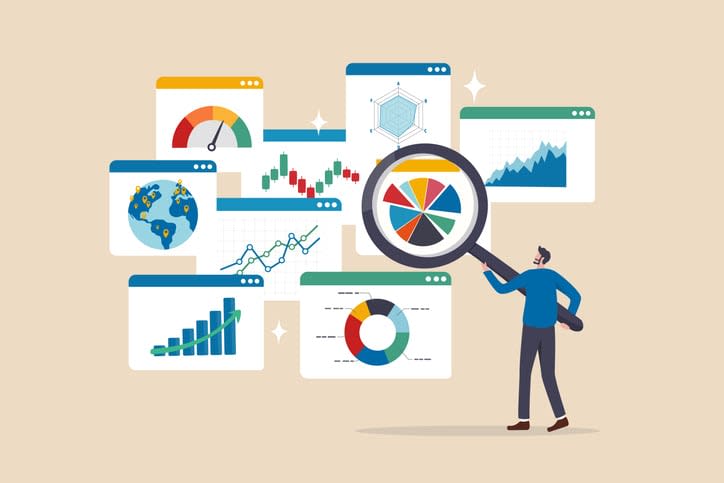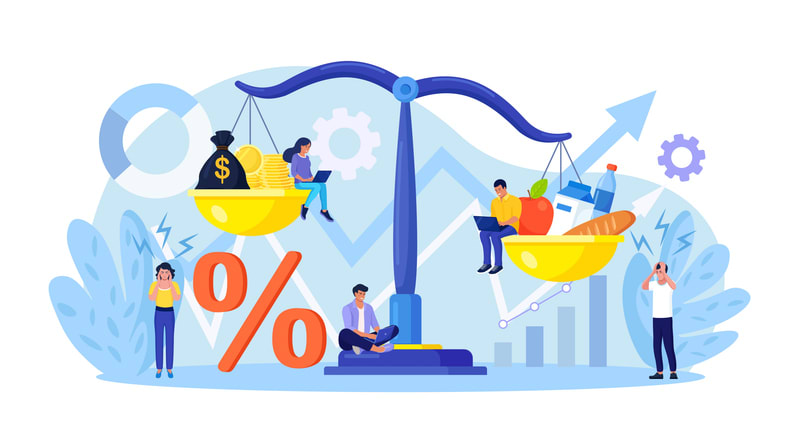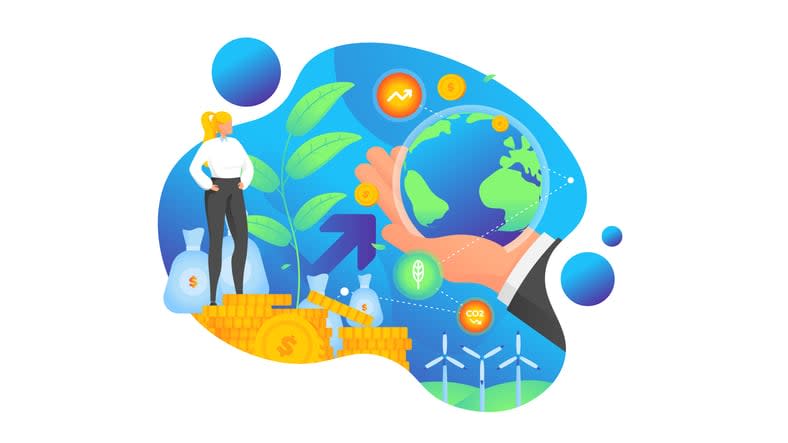What is the Solow growth model and how does it illuminate the path to economic development? This cornerstone of macroeconomic theory articulates the contributions of capital, labor, and technological innovation to an economy’s growth. By dissecting this framework, we unlock the dynamics of productivity, savings, and investment rates that lead to a state of steady advancement. Dive into the essence of the Solow growth model and its potent relevance in analyzing growth patterns.
Key takeaways
- The Solow Growth Model is instrumental in understanding long-term economic growth, emphasizing the roles of capital accumulation, labor, and technology, with economies tending toward a steady-state growth equilibrium.
- Technological progress, as captured by the Solow residual, is identified as a key driver of economic growth in the Solow Growth Model, which greatly contributes to improvements in output per capita and capital economic growth.
- Human capital is crucial for economic development, and the augmented Solow Model, which includes human capital, underlines its importance alongside physical capital in driving economic growth.
The Solow Growth Model: A Foundation for Economic Analysis

The Solow Growth Model was born out of the need to explain the mechanics of long-term economic growth. This model, which emerged in the late 1950s, shifted the focus of economists from short-term business cycles to long-term economic growth, marking a paradigm shift in the field of economics. This model underscored the importance of capital accumulation and technological progress in enhancing productivity and driving economic growth.
The model postulates that investments in capital and technological advancements play pivotal roles in improving labor productivity, including private sector investment. It emphasizes the importance of saving, the proper allocation of new capital goods, and the use of physical capital structures and equipment in businesses.
The Solow Growth Model also predicts that economies will eventually reach a balanced growth equilibrium, emphasizing diminishing returns to capital. It underscores the substantial effects of long-term growth given by the rule of 72 and the exponential nature of growth. Understanding this model is therefore crucial for anyone looking to grasp the intricacies of economic forces shaping a country’s growth rate and average annual growth.
Theoretical Framework
At the heart of the Solow Growth Model are three primary components: capital, labor, and technology. In this model, labor and capital are viewed as key factors of production, with variable capital-output ratios being considered.
The model represents economic growth using a nonlinear system, specifically a single differential equation that models the evolution of capital per capita. According to the Solow Growth Model, the growth of per capita capital stock is closely linked with labor growth and productivity increases.
Total factor productivity in the Solow Growth Model reflects the efficiency in the use of technology and capital. Crucially, technological advancement is a vital element of total factor productivity, making a significant contribution to the model’s explanation for economic expansion and productivity growth.
An increase in total factor productivity, encompassing technological efficiency, leads to a rise in output per capita.
Mathematical Representation
The mathematical representation of the Solow Growth Model focuses on the evolution of capital intensity, which is the ratio of capital to labor in the economy. The model is designed to approach a steady-state, where capital per worker and output per worker grow at the same rate.
In predicting economic growth, the Solow Model assumes diminishing returns to capital. This means that additional units of capital become less productive when the capital stock is large. The Inada conditions, which are part of the model, suggest that the elasticity of substitution between capital and labor tends to one as capital per worker goes to infinity.
The Solow residual is the part of output growth in the model that cannot be explained by capital accumulation. This represents the exogenous growth of total factor productivity, offering insights into the role of technological progress in driving economic growth.
Technological Progress and the Solow Model

The Solow-Swan model identifies technological progress as the key driver of long-term economic growth. This is indicated by the Solow residual, which measures the exogenous increase in total factor productivity (TFP) over time. The model suggests that workers can produce more output with the same stock of capital goods, characterizing this as a percentage increase in output per worker each year.
Historically, technological innovation has been paramount in driving economic growth. Technological progress accounts for a significant portion of the long-term rise in U.S. per capita income. It also plays a critical role in capita economic growth and economic convergence in growth models, where poorer countries catch up with richer ones in terms of income per capita.
The rate of technological growth influences:
- Savings and investment
- Research and development (R&D) activities
- Capital accumulation
- Economic development
This highlights the intertwined relationship between technological progress, capital accumulation, and economic development.
Technology's Role in Economic Expansion
Technology plays an essential role in augmenting labor productivity, which in turn increases the total output through improved efficiency of labor. As such, technological advancements are key drivers of productivity enhancements and sustainable economic expansion.
Human capital, defined as the skills possessed by the population or labor force, has been recognized for its significant external effects on national income, particularly when included in estimates of the augmented Solow model. Investments in human capital, alongside technological advancements in digital tools, have been crucial in driving economic growth.
One practical example of the implementation of the Solow-Swan model’s principles is Kumospace, a digital tool that facilitates technological integration and collaboration in virtual environments. This application of digital tools demonstrates how advancements in technology can enhance productivity and foster sustainable economic expansion, aligning with Solow-Swan model’s insights.
Examples of Technological Integration
Technological improvements have made a significant contribution to economic growth. Some of the key advancements include:
- Reduction of friction
- Transmission of power through electrification
- Reuse of heat
- Improvements in converting heat to work
These advancements have played a role in driving economic progress.
According to the Solow-Swan model, technological progress can facilitate higher returns on capital. This, in turn, attracts more investment in poorer countries, promoting economic growth and development.
Conditional convergence, a concept within the Solow-Swan model, suggests that poor countries can grow faster and catch up with richer countries. This is under the condition that they have similar investment rates and access to the same technology. This highlights the vital role that technological integration plays in narrowing the economic gap between countries.
Human Capital and Economic Growth

Human capital plays a crucial role in economic growth. Recognizing this, the Solow–Swan model has been augmented to include human capital, emphasizing its role in economic development. In the context of economic growth, human capital is defined as the skills possessed by the population or workforce.
Mankiw, Romer, and Weil pioneered the inclusion of human capital in the Solow Growth Model. They highlighted the importance of human capital alongside physical capital for economic growth. This recognition of the role of human capital has shaped our understanding of the drivers of economic growth, emphasizing the need for investments in both physical and human capital.
Investing in the health of the workforce is justified from an economic growth standpoint due to the significant role that health plays in the economy. Healthy individuals are more likely to be productive, contributing to the increase in output, which ultimately drives economic growth.
Importance of Human Capital Investment
Investment in human capital is crucial for sustained economic growth. The Solow–Swan model indicates that human capital complements physical capital, with both playing a key role in driving economic growth.
Human capital affects the productivity of physical capital. Countries with more human capital achieve higher economic outputs. This implies that investments in human capital not only benefit the individuals receiving the investment but also the wider economy, leading to overall economic growth.
Improvements in health are an important asset contributing to economic growth. Declining mortality rates trigger greater investments in individual human capital. The endogenous growth theory underscores that human capital can deliver increasing rates of return, fostering broad-based economic effects unlike physical capital.
Challenges in Measuring Human Capital
Measuring human capital can be challenging due to the various proxies used and the limitations they present. These proxies include:
- literacy levels
- numeracy
- book production per capita
- average formal schooling levels
- international test scores
- cumulative depreciated investment in formal schooling
The most prevalent proxy for human capital measurement is the average years of schooling in a country. This follows the database developed by Robert Barro and Jong-Wha Lee, which provides a comprehensive record of the average years of schooling across different countries and time periods.
However, the schooling attainment model for measuring human capital has been criticized for its exclusion of human capital developed outside formal schooling. This model ignores contributions from:
- families
- neighborhoods
- peers
- health
All of these factors can play a significant role in the development of human capital.
Government Policies and the Solow Growth Model

Government policies have played a significant role in shaping economic growth. Historically, policies that facilitated commerce and provided more personal and economic freedom were important in the adoption of capitalism, which influenced economic growth.
In the modern context, governments use various policy tools to stimulate economic growth. These include tax cuts, which increase personal disposable income and encourage businesses to hire and invest, and interest rate adjustments, which influence the cost of borrowing money and thus the level of investment in the economy.
However, governments also have a role in stabilizing economic growth. By raising interest rates, governments can combat price inflation and prevent the economy from overheating, ensuring a steady and sustainable rate of economic growth over time.
Transition to Capitalism
The transition to capitalism was a significant historical event that influenced economic growth. This transition was facilitated by various historical events and policies that promoted commerce and provided more personal and economic freedom.
One such event was the enclosure movement in 16th century England, which limited common land use and pushed the economy towards market-oriented agriculture. This set the stage for capitalist development. Around the same time, mercantilism emerged, featuring trade for profit and state intervention, which is considered an important precursor to capitalism[4.1_2]].
During the period of mercantilism, states played a crucial role by implementing controls, offering subsidies, and granting monopolies. This laid the groundwork for the development of capitalist institutions, highlighting the role of government policies in shaping economic systems and growth.
Government Intervention in Modern Economies
In modern economies, government intervention plays a crucial role in promoting sustainable economic growth. One of the key areas where government intervention is necessary is in policies focusing on climate change mitigation. The Stern Review on the Economics of Climate Change suggested that an investment equivalent to 1% of GDP, which was later revised to 2%, would be sufficient to prevent the most severe impacts of climate change on the world economy. This highlights the level of government intervention needed in the economy to ensure long-term growth and sustainability.
Through policies such as these, governments can shape the direction of economic growth, promoting a transition to a more sustainable and resilient economy. This underscores the importance of government policies in influencing economic growth trajectories and the need for policies that promote both economic development and environmental sustainability.
Environmental Implications of the Solow Growth Model

The Solow Growth Model, like all economic models, has environmental implications. One of the key considerations is the constraint posed by finite resources on growth. As economies develop, they demand more resources, particularly energy, which are finite in nature.
There is a significant correlation between a nation’s economic growth and its carbon dioxide emissions rates, which can be influenced by population growth. This highlights the environmental impact of economic growth and the challenges posed by the need to balance economic development with environmental sustainability.
To maintain average global temperature increases below 2 °C, the carbon budget from 2010 onwards was set at 1.111 trillion tons. However, by 2010, humanity had already emitted 530 billion tons of cumulative carbon emissions. This underscores the urgency of finding ways to balance economic growth with environmental sustainability.
Resource Constraints and Sustainability
Resource constraints can pose barriers to long-term economic growth. There is a strong correlation between per capita electricity consumption and economic development, suggesting that as economies develop, they demand more resources, primarily energy.
The reliance on finite natural resources like fossil fuels for generating electricity can pose a significant barrier to sustaining long-term economic growth. Without transitioning to sustainable energy sources, resource constraints could eventually lead to a stagnation or decline in economic development.
This highlights the importance of investing in sustainable energy sources and technologies. By transitioning to renewable energy, it is possible to overcome these resource constraints and ensure a more sustainable path of economic development.
Alternative Approaches to Economic Growth
In light of the environmental implications of the Solow Growth Model, alternative approaches to economic growth have been developed. These approaches, such as green growth and the circular economy model, focus on environmental sustainability and resource efficiency.
Green Growth is an economic growth paradigm that includes environmental sustainability and resource efficiency as key components of economic development. This approach aims to decouple economic growth from environmental degradation, promoting a form of growth that is both economically and environmentally sustainable.
The circular economy model is another alternative approach to economic growth. This model is grounded in the reduction of waste and the continuous use of resources through principles of reuse, repair, and recycling. It aims to create a closed-loop system for materials, promoting resource efficiency and reducing the environmental impact of economic growth.
Criticisms and Limitations of the Solow Growth Model

Like any model, the Solow Growth Model has its limitations and criticisms. One criticism is that the aggregate, supply-side nature of the model, which uses a single production function to represent economic output, is not sufficient to capture the complexity of different forms of output and investments.
The representation of human and physical capital by an identical production function is also considered unrealistic within the Solow Growth Model. This simplification overlooks the unique characteristics and contributions of human capital and physical capital to economic growth.
The Solow Model’s convergence theory, which postulates that poorer nations will inevitably catch up to richer ones, is not consistently observed across all economies. Moreover, the model’s assumption of a closed economy disregards the interconnectedness and trade dynamics of modern global economies.
Inequality and Income Distribution
Inequality and income distribution play a significant role in economic growth. How widely the fruits of growth are shared is crucial for the perpetuation of that growth and the overall well-being and advancement of society.
According to the Galor-Zeira model, income inequality has a negative impact on GDP per capita in rich countries, while it has a positive effect in poor countries. This highlights the complex relationship between income distribution and economic growth and the varying effects in different countries.
Income inequality influences human capital accumulation. Here are some key points to consider:
- Investments in education tend to raise human capital in lower-income countries
- Investments in education have a diminishing impact in countries with middle and high incomes
- Tailored approaches to education policy based on a country’s economic status are needed
- Addressing income inequality is important in strategies to promote human capital accumulation and economic growth
Endogenous Growth Theory
Endogenous growth theory emerged as a response to the limitations of classical growth theory and the neoclassical growth model, such as the Solow Model. By incorporating the neoclassical growth theory, it offers a more comprehensive framework that accounts for sustained economic growth through internal mechanisms such as human capital investment and innovation.
Economic growth in the Endogenous Growth Theory is proposed to be generated from within the economy through mechanisms such as human capital investment, innovation, and knowledge spill-overs. This contrasts with the Solow Model, which relies on exogenous technological shocks to drive economic growth.
The Endogenous Growth Theory serves as a foundational platform for further extensions like the Ramsey–Cass–Koopmans model. This model adds the aspect of endogenous saving rates to the growth discussion, illustrating the dynamic and multi-faceted nature of economic growth.
Summary
This blog post has provided an in-depth analysis of the Solow Growth Model, a foundational concept in economics that emphasizes the role of capital accumulation and technological progress in driving long-term economic growth. We have explored the theoretical framework and mathematical representation of the model, and discussed the role of technological progress and human capital in economic growth.
We have also examined the environmental implications of the Solow Growth Model and discussed alternative approaches to economic growth that emphasize environmental sustainability and resource efficiency. The blog post has highlighted the criticisms and limitations of the Solow Growth Model and introduced the Endogenous Growth Theory, which emerged as a response to these limitations.
In conclusion, while the Solow Growth Model has its limitations, it remains a fundamental concept in economics that provides crucial insights into the mechanisms of economic growth. As we continue to grapple with the challenges of economic development, inequality, and environmental sustainability, the principles of the Solow Growth Model provide a valuable framework for understanding and addressing these issues.
Frequently Asked Questions
The key components of the Solow Growth Model are capital, labor, and technology. These elements are essential for understanding long-term economic growth.
Technological progress allows workers to produce more output with the same stock of capital goods, driving economic growth according to the Solow Growth Model.
Human capital is essential for economic growth as it enhances the productivity of physical capital, according to the Solow Growth Model.
Some criticisms of the Solow Growth Model include its inability to capture the complexity of various outputs and investments, as well as inconsistencies in the observed convergence theory. These factors question the model's efficacy in representing real-world economic dynamics.
The Endogenous Growth Theory addresses the shortcomings of the Solow Model, offering a more extensive framework that explains sustained economic growth through internal factors like human capital investment and innovation.





